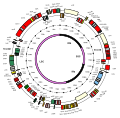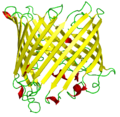Chloroplast DNA
Chloroplast DNA (cpDNA) is the DNA located within chloroplasts, which are the photosynthetic organelles found in the cells of plants and green algae. Chloroplast DNA is circular, and it varies in size from 120 to 170 kilobase pairs in most plants, containing between 100 and 120 genes. These genes are involved in chloroplast function, with roles in photosynthesis, chloroplast development, and other processes specific to the chloroplast.
Structure and Features[edit]
Chloroplast DNA is characterized by its circular double-stranded DNA structure, which is similar to that of bacterial DNA, reflecting the evolutionary origin of chloroplasts via endosymbiosis. The cpDNA is located in the chloroplast stroma, and it is organized into discrete structures known as nucleoids. Each chloroplast contains multiple copies of its DNA, ensuring redundancy and robustness in the genetic information.
Genetic Content[edit]
The genetic content of cpDNA includes genes encoding for parts of the photosynthetic apparatus, such as Photosystem I, Photosystem II, the cytochrome b6f complex, and ATP synthase. It also contains genes for the synthesis of ribosomal RNA (rRNA) and a variety of transfer RNA (tRNA) molecules, which are necessary for protein synthesis within the chloroplast. Additionally, cpDNA encodes a small number of ribosomal proteins and other proteins essential for chloroplast function.
Inheritance[edit]
Chloroplast DNA is typically inherited in a non-Mendelian manner, with most plants exhibiting maternal inheritance, where the offspring's cpDNA comes exclusively from the mother via the egg cell. However, exceptions exist, including paternal or biparental inheritance in some species.
Evolution[edit]
The presence of DNA within chloroplasts supports the endosymbiotic theory, which proposes that chloroplasts originated from free-living photosynthetic bacteria that were engulfed by a non-photosynthetic eukaryotic cell. Over time, the engulfed bacteria evolved into chloroplasts, transferring some of their genes to the host cell's nucleus, but retaining a reduced genome within the chloroplast.
Applications[edit]
Chloroplast DNA has been widely used in molecular systematics and phylogenetics to infer evolutionary relationships among plants. Due to its relatively conserved nature and maternal inheritance, cpDNA provides a useful marker for studying plant evolution and diversity. Additionally, genetic engineering of cpDNA has potential applications in biotechnology, including the development of transgenic plants with improved traits such as resistance to pests or environmental stresses.
See Also[edit]
-
Plastomap of Arabidopsis thaliana
-
Chloroplast DNA Replication
-
Adenine Deaminates to Guanine
-
Tetrapeptide Structural Formulae
-
TOC34
-
Sucrose Porin
Ad. Transform your life with W8MD's Budget GLP-1 injections from $75


W8MD offers a medical weight loss program to lose weight in Philadelphia. Our physician-supervised medical weight loss provides:
- Weight loss injections in NYC (generic and brand names):
- Zepbound / Mounjaro, Wegovy / Ozempic, Saxenda
- Most insurances accepted or discounted self-pay rates. We will obtain insurance prior authorizations if needed.
- Generic GLP1 weight loss injections from $75 for the starting dose.
- Also offer prescription weight loss medications including Phentermine, Qsymia, Diethylpropion, Contrave etc.
NYC weight loss doctor appointmentsNYC weight loss doctor appointments
Start your NYC weight loss journey today at our NYC medical weight loss and Philadelphia medical weight loss clinics.
- Call 718-946-5500 to lose weight in NYC or for medical weight loss in Philadelphia 215-676-2334.
- Tags:NYC medical weight loss, Philadelphia lose weight Zepbound NYC, Budget GLP1 weight loss injections, Wegovy Philadelphia, Wegovy NYC, Philadelphia medical weight loss, Brookly weight loss and Wegovy NYC
|
WikiMD's Wellness Encyclopedia |
| Let Food Be Thy Medicine Medicine Thy Food - Hippocrates |
Medical Disclaimer: WikiMD is not a substitute for professional medical advice. The information on WikiMD is provided as an information resource only, may be incorrect, outdated or misleading, and is not to be used or relied on for any diagnostic or treatment purposes. Please consult your health care provider before making any healthcare decisions or for guidance about a specific medical condition. WikiMD expressly disclaims responsibility, and shall have no liability, for any damages, loss, injury, or liability whatsoever suffered as a result of your reliance on the information contained in this site. By visiting this site you agree to the foregoing terms and conditions, which may from time to time be changed or supplemented by WikiMD. If you do not agree to the foregoing terms and conditions, you should not enter or use this site. See full disclaimer.
Credits:Most images are courtesy of Wikimedia commons, and templates, categories Wikipedia, licensed under CC BY SA or similar.
Translate this page: - East Asian
中文,
日本,
한국어,
South Asian
हिन्दी,
தமிழ்,
తెలుగు,
Urdu,
ಕನ್ನಡ,
Southeast Asian
Indonesian,
Vietnamese,
Thai,
မြန်မာဘာသာ,
বাংলা
European
español,
Deutsch,
français,
Greek,
português do Brasil,
polski,
română,
русский,
Nederlands,
norsk,
svenska,
suomi,
Italian
Middle Eastern & African
عربى,
Turkish,
Persian,
Hebrew,
Afrikaans,
isiZulu,
Kiswahili,
Other
Bulgarian,
Hungarian,
Czech,
Swedish,
മലയാളം,
मराठी,
ਪੰਜਾਬੀ,
ગુજરાતી,
Portuguese,
Ukrainian





